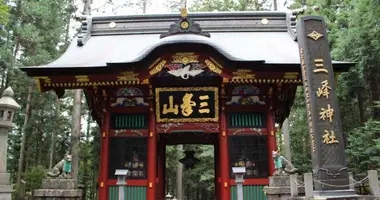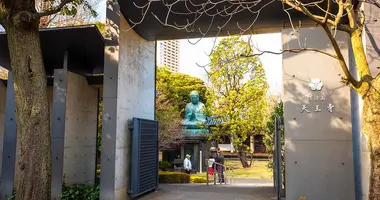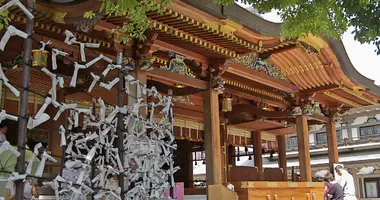Toyokawa Inari Akasaka: A spiritual oasis in the heart of Tokyo
- Published on : 27/07/2024
- by : Japan Experience
- Youtube
Nestled in the bustling Akasaka district of Tokyo, Toyokawa Inari Betsuin Temple stands as a unique spiritual sanctuary. This remarkable institution blends Buddhist and Shinto traditions, offering visitors a glimpse into Japan's rich religious tapestry. With its distinctive red lanterns and hundreds of fox statues, the temple attracts both devout worshippers and curious tourists alike. As you step through its gates, you'll find yourself transported from the modern cityscape to a world of ancient rituals and mystical beliefs. Whether you're seeking spiritual guidance, cultural insights, or simply a moment of tranquility, Toyokawa Inari Akasaka promises an unforgettable experience in the heart of Tokyo.
History and significance of Toyokawa Inari Betsuin
The story of Toyokawa Inari Betsuin is deeply rooted in Japanese history. Established in 1828 at its present site in Moto-Akasaka, the temple is a branch of the main Toyokawa Inari Shrine located in Aichi Prefecture. The temple's origins can be traced back to a vision experienced by the third son of Emperor Juntoku in the 13th century, who saw the deity Dakini-Shinten riding a white fox.
During the Meiji era, when Buddhism faced persecution, Toyokawa Inari Betsuin cleverly maintained its Buddhist identity by asserting that its primary object of worship was the Buddhist deity Dakini-Shinten, rather than the Shinto fox god. This strategic move allowed the temple to survive and flourish, becoming a unique example of religious syncretism in Japan.
The temple's significance grew over time, and it became particularly associated with the entertainment industry. Its proximity to the former red-light district of Akasaka-mitsuke contributed to its popularity among artists, musicians, and performers, who would visit to pray for success and good fortune.
Key deities and their spiritual powers
At the heart of Toyokawa Inari Akasaka's spiritual landscape are several key deities, each with their own unique powers and significance:
- Dakini-Shinten: The principal deity, often depicted riding a white fox. Dakini-Shinten is associated with wisdom and transformation.
- Inari Okami: The Shinto god of fertility, rice, agriculture, and success. Inari is represented by the numerous fox statues throughout the temple grounds.
- Benzaiten (Benten): The only female among Japan's Seven Lucky Gods, she is revered by artists and entertainers for her association with music, eloquence, and the arts.
- Yuzu Inari Sonten: Known as the god of wealth, with a dedicated shrine within the temple complex.
- Kodakura Kannon Bosatsu: The bodhisattva of childbirth, popular among expectant mothers seeking blessings for safe delivery.
These deities collectively offer protection, prosperity, artistic inspiration, and fertility, making Toyokawa Inari Akasaka a versatile spiritual destination catering to a wide range of needs and aspirations.
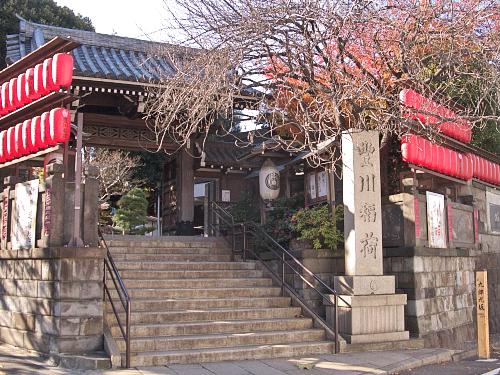
Entrance to Toyokawa Inari Temple, Akasaka, Tokyo.
Temple layout and main attractions
The layout of Toyokawa Inari Akasaka is designed to create a immersive spiritual experience. As you enter, you'll be greeted by the sight of red lanterns adorning the long earthen wall along Aoyama-dori Avenue, immediately setting the mood for your visit.
The temple grounds are home to several key attractions:
- Main Temple Building: The central structure, freely accessible to visitors, showcases a unique blend of Buddhist and Shinto elements. Inside, you'll find a mix of Buddhist decorations and the Shinto mirror as the object of veneration.
- Thousand Red Banners: These fluttering flags, representing prayers for health, wealth, and safety, create a vibrant and dynamic atmosphere.
- Fox Statues: Hundreds of stone fox statues, known as Inari foxes, are scattered throughout the grounds. Each statue is unique, varying in size, posture, and expression.
- Benzaiten Shrine: Located to the left of the Main Temple, this shrine is particularly popular among artists and entertainers.
- Kodakura Kannon Bosatsu Statue: A large statue of the bodhisattva of childbirth stands against the eastern wall, attracting expectant mothers.
As you explore the Toyokawa Inari Precincts, you'll discover a harmonious blend of natural beauty and spiritual symbolism, creating a peaceful retreat from the bustling city outside.
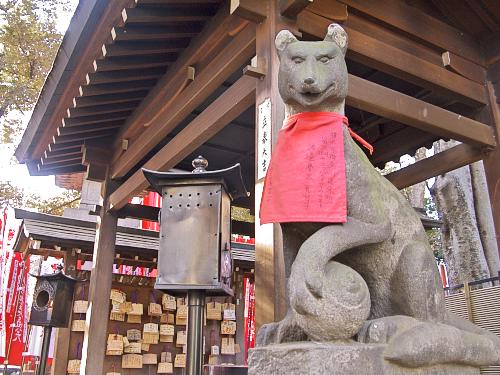
Stone Inari fox statue, Toyokawa Inari Temple, Akasaka, Tokyo.
Rituals and proper etiquette for visitors
To fully appreciate and respect the spiritual significance of Toyokawa Inari Akasaka, visitors should observe certain rituals and etiquette:
- Purification: Before entering the main worship area, perform a simple purification ritual at the water fountain near the entrance. Rinse your hands and mouth to cleanse yourself symbolically.
- Offering: It's customary to make a small monetary offering at the main hall. Place your contribution in the offering box and bow slightly.
- Prayer: When praying, ring the temple bell gently to attract the attention of the deities. Then, bow twice, clap twice, and bow once more. This is the standard Shinto prayer ritual, adapted for this syncretic temple.
- Respect for sacred spaces: Avoid taking photographs inside the main hall or other designated prayer areas. Maintain a quiet and respectful demeanor throughout your visit.
- Amulets and fortunes: You may purchase amulets (omamori) or draw fortune slips (omikuji) as part of your visit. These are available at the temple office.
Remember, Toyokawa Inari Akasaka is an active place of worship. By following these guidelines, you'll ensure a respectful and meaningful experience for yourself and others.
Cultural and religious importance in modern Japan
Toyokawa Inari Akasaka holds a unique position in modern Japanese society, bridging traditional spiritual practices with contemporary needs. Its significance extends beyond religious boundaries, making it a cultural landmark in Tokyo.
The temple's association with the entertainment industry has solidified its place in popular culture. On New Year's Eve, it becomes a focal point for celebrities, artists, and performers who come to pray for success in the coming year. This tradition has elevated the temple's profile and attracts media attention annually.
Moreover, Toyokawa Inari Akasaka serves as a living example of religious syncretism in Japan. In a country where many people practice a blend of Shinto and Buddhist traditions, this temple embodies the harmonious coexistence of these belief systems. It demonstrates how ancient traditions can adapt and remain relevant in a rapidly changing society.
The temple also plays a role in preserving traditional crafts and arts. Its ornate decorations, including the famous red lanterns and intricate fox statues, support artisans who specialize in these traditional crafts. This contributes to the continuity of Japan's cultural heritage in the heart of its most modern city.
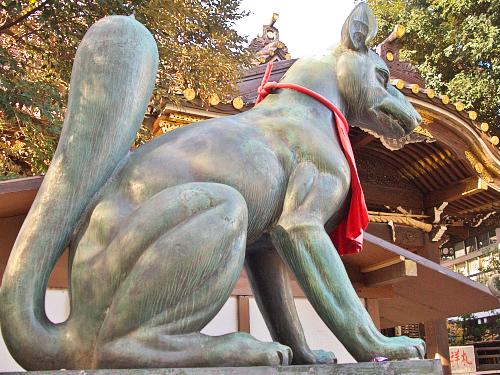
Inari fox statue in front of the Main Temple, Toyokawa Inari Temple, Akasaka, Tokyo.
How to access Toyokawa Inari Akasaka
Located in the heart of Tokyo, Toyokawa Inari Access is conveniently accessible by public transportation:
- By Subway:
- From Akasaka-mitsuke Station (Ginza and Marunouchi Lines): Take Exit 8 and walk about 3 minutes up Aoyama-dori Avenue.
- From Nagatacho Station (Namboku, Yurakucho, and Hanzomon Lines): Use Exit 8 (shared with Akasaka-mitsuke Station) and follow the same route.
- Address: 1-4-7 Motoakasaka, Minato-ku, Tokyo 107-0051
- Opening Hours: The temple is typically open from 6:00 AM to 8:00 PM daily.
The temple's central location in Akasaka makes it easily combinable with other nearby attractions, such as the State Guest House Akasaka Palace or the vibrant streets of Akasaka-mitsuke. Whether you're a spiritual seeker, culture enthusiast, or curious traveler, Toyokawa Inari Akasaka offers a unique glimpse into Tokyo's spiritual heart.
Visitor information and practical tips
To make the most of your visit to Toyokawa Inari Akasaka, consider these practical tips:
- Best time to visit: Early morning or late afternoon tends to be less crowded. However, visiting during New Year's Eve or New Year's Day offers a unique cultural experience, albeit with larger crowds.
- Admission: Entry to the temple grounds is free.
- Duration: Allow about 30-60 minutes for a thorough exploration of the temple grounds.
- Photography: While photos are allowed in most areas, be respectful and avoid photographing worshippers or inside the main hall.
- Accessibility: The temple has some steps and uneven ground, which may pose challenges for visitors with mobility issues.
- Nearby amenities: The surrounding Akasaka area offers numerous restaurants, cafes, and shops for before or after your visit.
Remember, Toyokawa Inari Akasaka is more than just a tourist attraction; it's a living, breathing spiritual center. Approach your visit with respect and an open mind, and you'll discover a fascinating blend of history, culture, and spirituality in the heart of Tokyo. Whether you're drawn by its unique architecture, intrigued by its syncretic traditions, or seeking a moment of peace in the bustling city, Toyokawa Inari Akasaka offers a memorable experience for all who enter its gates.















